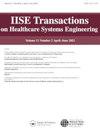SHERPA技术在眼科手术室中识别和评估人为错误的应用:斜视手术过程的案例研究
IF 1.5
Q3 HEALTH CARE SCIENCES & SERVICES
IISE Transactions on Healthcare Systems Engineering
Pub Date : 2022-07-20
DOI:10.1080/24725579.2022.2096155
引用次数: 0
摘要
摘要背景眼科手术对人为失误非常敏感,会降低患者的安全性,造成不可挽回的伤害。这项研究将显示眼科手术中人为错误发生的地方和原因,并将其最小化。目的本研究旨在证明使用一种简单实用的技术来分析眼科手术过程以识别人为错误管理机会的可行性。方法利用HTA分析斜视手术及其相关过程(如患者麻醉和术后恢复),并利用SHERPA技术识别和评估任务和子任务中可能存在的人为错误。结果活动分为83个任务和子任务。对HTA结果的调查导致鉴定出58个可能的错误。动作错误发生率最高,为64%,其次是检查错误、检索错误和选择错误,分别为17%、12%和7%。根据结果,5%的错误处于不可接受的风险水平,50%的错误处于不希望的风险水平,31%的错误处于可接受的风险水平,但有修订要求,14%的错误处于可接受的风险水平,无需修订。结论本研究表明,在眼科手术中使用人的可靠性分析方法具有以下主要优势:识别出错概率最高的区域,通过确定风险水平或发生概率对出错进行优先排序,并提供适当的控制方案,将出错风险降至最低。本文章由计算机程序翻译,如有差异,请以英文原文为准。
Application of SHERPA technique in ophthalmic operating rooms to identify and evaluate human errors: a case study of strabismus surgery process
Abstract Background Eye surgeries are very sensitive to human errors that can reduce the patient's safety and cause irreparable damage. This study will show where and why human errors occur during eye surgery and minimize them. Purpose This study was conducted to demonstrate the feasibility of using a simple and practical technique for analyzing the process of eye surgeries to identify opportunities for managing human error. Methods The basis of this study is the analysis of strabismus surgery and related processes (such as patient anesthesia and postoperative recovery) using the HTA and the identification and evaluation of probable human errors in the tasks and sub-tasks using the SHERPA technique. Results The activities were divided into 83 tasks and sub-tasks. Investigations of the findings of HTA resulted in the identification of 58 probable errors. Action errors with a prevalence rate of 64% had the highest frequency, followed by checking, retrieval, and selection errors with 17%, 12%, and 7%, respectively. Based on the results, 5% of the errors were at the unacceptable risk level, 50% at undesirable risk level, 31% at acceptable risk level but with revision requirements, and 14% at acceptable risk level without the need for revision. Conclusions This study showed that the use of human reliability analysis methods in eye surgeries can have major advantages such as: identifying the areas with the highest probability of error, prioritizing error by determining the level of risk or probability of their occurrence and providing appropriate control solutions to minimize the risk of error.
求助全文
通过发布文献求助,成功后即可免费获取论文全文。
去求助
来源期刊

IISE Transactions on Healthcare Systems Engineering
Social Sciences-Safety Research
CiteScore
3.10
自引率
0.00%
发文量
19
期刊介绍:
IISE Transactions on Healthcare Systems Engineering aims to foster the healthcare systems community by publishing high quality papers that have a strong methodological focus and direct applicability to healthcare systems. Published quarterly, the journal supports research that explores: · Healthcare Operations Management · Medical Decision Making · Socio-Technical Systems Analysis related to healthcare · Quality Engineering · Healthcare Informatics · Healthcare Policy We are looking forward to accepting submissions that document the development and use of industrial and systems engineering tools and techniques including: · Healthcare operations research · Healthcare statistics · Healthcare information systems · Healthcare work measurement · Human factors/ergonomics applied to healthcare systems Research that explores the integration of these tools and techniques with those from other engineering and medical disciplines are also featured. We encourage the submission of clinical notes, or practice notes, to show the impact of contributions that will be published. We also encourage authors to collect an impact statement from their clinical partners to show the impact of research in the clinical practices.
 求助内容:
求助内容: 应助结果提醒方式:
应助结果提醒方式:


